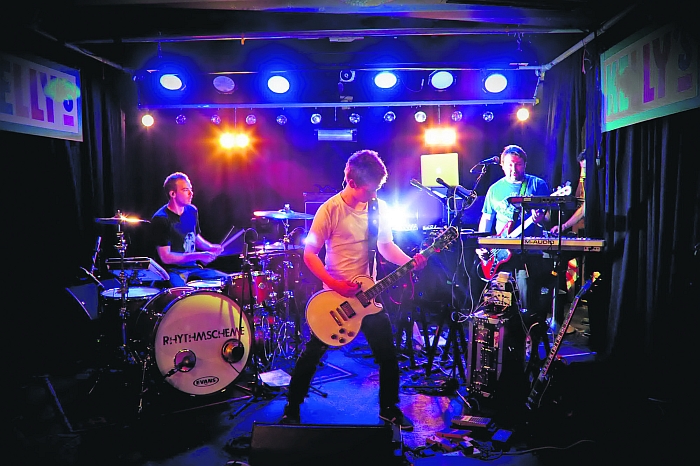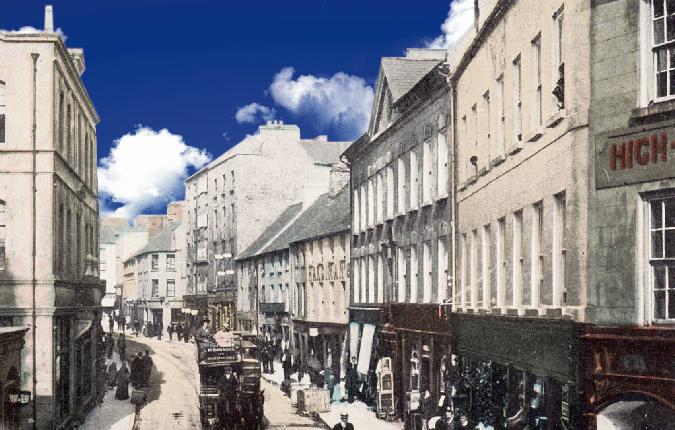Archive News
Loud and vibrant musical mix from Rhythm Scene

Date Published: 12-Dec-2012
It might get loud, but you’ll have fun at Rhythm Scheme show. Fusing a DJ set with live instruments, the band have proven to be a hugely popular since starting a residency in the city’s Kelly’s Bar just over a year ago.
Rhythm Scheme are Jonathan ‘Byrno’ Byrne, Edward Martin, Jimmy Moran and James Corballis. Byrno has been DJ-ing in Galway for over 10 years, but was looking for a new project when Ed approached him.
“I was playing a gig and this guy came up to chat to me at the end of the night,” says Byrno. “A very pleasant American guy, [he] introduced himself in a very American fashion by giving me his full name and pretty much all of his address!
“He said ‘I’m moving to Ireland soon, I’m a drummer and I’d like to do something.’ When Ed moved here permanently we started to work, that was about three years ago.”
After playing some show together, Byrno and Ed christened their project and decided to add something new to the mix.
“In October 2011 we came up with the name Rhythm Scheme and launched it as a proper live act,” Byrno says. “I think it was December 2011 that we brought in a guitar player. Initially it was Barry Morley, then he moved to London. He was replaced by Des Foley, then myself for one gig, then we managed to get young Jimmy Moran.
“When I was younger I had been in bands and unsuccessfully tried to be a musician. So it had always been in the back of my head that I’d love to go back and do something like that. I was just lucky enough that I found people who were willing enough to put in the time and effort.”
Jimmy Moran has played in rock bands before, but linking up with Byrno’s electronic sounds was something new for him.
“It’s been interesting, the whole combination of a DJ set with live instruments,” says the guitarist. “I’d been to a good few of their shows. I know the lads, and I was always dying to get up anyway. Sometimes you have to make the guitar not sound like a guitar. You have to have a few different sounds. And other times you have to make the guitar sound like a guitar, for the craic. Just go for it!”
Rhythm Scheme take contemporary tunes and chop them up, then throw live music on top of that. It’s a combination that has seen them pack out Kelly’s music venue on Bridge every month– but it’s tricky to box it into a genre.
“Some people think we’re a rock band who play dance music, or we’re a dance band that does rock music,” says Byrno. “I’d like to think we’re neither of those things. I’d like to think it’s a show, and we’re making already pretty interesting tunes a tad more interesting, and putting our own spin on it.”
Rhythm Scheme are constantly tinkering with their sound, at the behest of their drummer.
For more, read this week’s Connacht Tribune.
Galway in Days Gone By
The way we were – Protecting archives of our past

People’s living conditions less than 100 years ago were frightening. We have come a long way. We talk about water charges today, but back then the local District Councils were erecting pumps for local communities and the lovely town of Mountbellew, according to Council minutes, had open sewers,” says Galway County Council archivist Patria McWalter.
Patria believes we “need to take pride in our history, and we should take the same pride in our historical records as we do in our built heritage”. When you see the wealth of material in her care, this belief makes sense.
She is in charge of caring for the rich collection of administrative records owned by Galway County Council and says “these records are as much part of our history as the Rock of Cashel is. They document our lives and our ancestors’ lives. And nobody can plan for the future unless you learn from the past, what worked and what didn’t”.
Archivists and librarians are often unfairly regarded as being dry, academic types, but that’s certainly not true of Patria. Her enthusiasm is infectious as she turns the pages of several minute books from Galway’s Rural District Councils, all of them at least 100 years old.
Part of her role involved cataloguing all the records of the Councils – Ballinasloe, Clifden, Galway, Gort, Loughrea, Mountbellew, Portumna and Tuam. These records mostly consisted of minutes of various meetings.
When she was cataloguing them she realised their worth to local historians and researchers, so she decided to compile a guide to their content. The result is For the Record: The Archives of Galway’s Rural District Councils, which will be a valuable asset to anybody with an interest in history.
Many representatives on these Councils were local personalities and several were arrested during the political upheaval of the era, she explains.
And, ushering in a new era in history, women were allowed to sit on these Rural District Councils – at the time they were not allowed to sit on County Councils.
All of this information is included in Patria’s introductory essay to the attractively produced A4 size guide, which gives a glimpse into how these Rural Councils operated and the way political thinking changed in Ireland during a short 26-year period. In the early 1900s, these Councils supported Home Rule, but by 1920, they were calling for full independence and refusing to recognise the British administration.
“I love the tone,” says Patria of the minutes from meetings. “The language was very emotive.”
That was certainly true of the Gort Rural District Council. At a meeting in 1907, following riots in Dublin at the premiere of JM Synge’s play, The Playboy of the Western World the councillors’ response was vehement. They recorded their decision to “protest most emphatically against the libellous comedy, The Playboy of the Western World, that was belched forth during the past week in the Abbey Theatre, Dublin, under the fostering care of Lady Gregory and Mr Yeats. We congratulate the good people of Dublin in howling down the gross buffoonery and immoral suggestions that are scattered throughout this scandalous performance.
For more from the archives see this week’s Tribunes here
Archive News
Galway have lot to ponder in poor show

Date Published: 23-Jan-2013
SLIGO 0-9
GALWAY 1-4
FRANK FARRAGHER IN ENNISCRONE
GALWAY’S first serious examination of the 2013 season rather disturbingly ended with a rating well below the 40% pass mark at the idyllic, if rather Siberian, seaside setting of Enniscrone on Sunday last.
The defeat cost Galway a place in the FBD League Final against Leitrim and also put a fair dent on their confidence shield for the bigger tests that lie ahead in February.
There was no fluke element in this success by an understrength Sligo side and by the time Leitrim referee, Frank Flynn, sounded the final whistle, there wasn’t a perished soul in the crowd of about 500 who could question the justice of the outcome.
It is only pre-season and last Sunday’s blast of dry polar winds did remind everyone that this is far from summer football, but make no mistake about it, the match did lay down some very worrying markers for Galway following a couple of victories over below par third level college teams.
Galway did start the game quite positively, leading by four points at the end of a first quarter when they missed as much more, but when Sligo stepped up the tempo of the game in the 10 minutes before half-time, the maroon resistance crumbled with frightening rapidity.
Some of the statistics of the match make for grim perusal. Over the course of the hour, Galway only scored two points from play and they went through a 52 minute period of the match, without raising a white flag – admittedly a late rally did bring them close to a draw but that would have been very rough justice on Sligo.
Sligo were backable at 9/4 coming into this match, the odds being stretched with the ‘missing list’ on Kevin Walsh’s team sheet – Adrian Marren, Stephen Coen, Tony Taylor, Ross Donovan, David Kelly, David Maye, Johnny Davey and Eamon O’Hara, were all marked absent for a variety of reasons.
Walsh has his Sligo side well schooled in the high intensity, close quarters type of football, and the harder Galway tried to go through the short game channels, the more the home side bottled them up.
Galway badly needed to find some variety in their attacking strategy and maybe there is a lot to be said for the traditional Meath style of giving long, quick ball to a full forward line with a big target man on the edge of the square – given Paul Conroy’s prowess close to goal last season, maybe it is time to ‘settle’ on a few basics.
Defensively, Galway were reasonably solid with Gary Sice at centre back probably their best player – he was one of the few men in maroon to deliver decent long ball deep into the attacking zone – while Finian Hanley, Conor Costello and Gary O’Donnell also kept things tight.
For more, read this week’s Connacht Tribune.
Archive News
Real Galway flavour to intermediate club hurling battle in Birr

Date Published: 23-Jan-2013
images/files/images/x3_Courthouse.jpg










